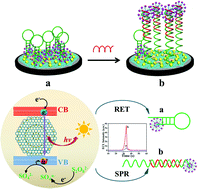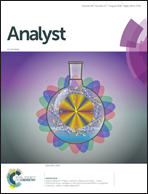Cathodic electrochemiluminescence behaviour of MoS2 quantum dots and its biosensing of microRNA-21
Abstract
The cathodic electrochemiluminescence (ECL) behaviour of nontoxic MoS2 quantum dots (QDs) was studied for the first time using potassium peroxydisulfate as the co-reactant. Ag-PAMAM NCs, serving as difunctional tags for quenching and enhancing ECL of MoS2-reduced graphene oxide composites, were introduced into the ECL detection system for signal amplification. By modulating the interparticle distance between MoS2 QDs and Ag-PAMAM NCs, the ECL quenching from resonance energy transfer and the ECL enhancement from surface plasma resonance were realized. Coupling the good ECL performance of MoS2 QDs with the excellent ECL quenching and enhancement effects of Ag-PAMAM NCs, a novel MoS2 QDs-based ECL biosensing platform for sensitive detection of microRNA-21 was achieved with a detection limit of 0.20 fmol L−1 (S/N = 3). This method was successfully applied to the determination of microRNA-21 in human serum samples with recoveries of 90.0–110.0%, suggesting great potential for its applications in biological and chemical analysis.



 Please wait while we load your content...
Please wait while we load your content...